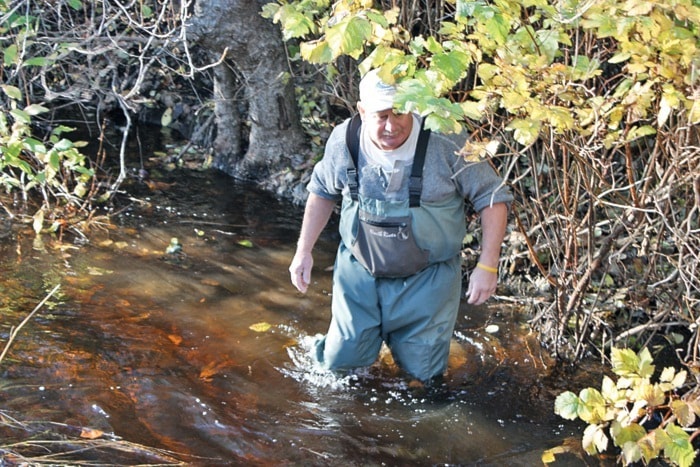Just off the side of the highway Dave Cunning is trolling for fish. But there’s no boat or bait involved.
Instead, Cunning is using his bare hands and wading through Simms Creek to take down the daily fish count at the fence he checks every single day.
The fence is one of three in Campbell River streams – Simms, Woods, and Casey creeks – that exist to help local streamkeepers keep track of seasonal fish stocks. They were all built by Campbell River’s Grant Erickson.
The fences “determine that we’re getting returns,” says Bob Tonkin, one of the Simms Creek streamkeepers.
“Some come back that are marked hatchery fish,” Tonkin says. “We clipped them (the back fin) before putting them in the creek; we usually put in 5,000 each year to make sure they’re coming back.”
The fences help the streamkeepers determine whether they’re getting healthy fish stocks but that’s not always easy on Simms Creek.
“It’s difficult in this particular creek because we have huge fluctuations in water depth,” Tonkin says. “Last year the water was so high we had to pull the gates because it was eroding the banks. Then we don’t get a fish count.”
The number of fish passing through urban Simms Creek, which runs right through the city, has also been slightly dwindling over the past few years. This fall’s fish counts (reported at the end of this story) are average compared to the last couple of years but the numbers have been better.
“We used to have more fish a few years ago apparently but development denigrates the environment,” Tonkin says. “The Beaver Lodge Lands have been a saviour for this creek because there’s no development (permitted) in it. It helps a lot.”
The fence on Simms Creek is just off the upgraded section of the Old Island Highway between Hilchey and Forberg roads. The fence temporarily thwarts the salmon from swimming up stream and instead directs them into a rectangular shaped trap where Cunning counts the fish, measures them, determines whether they’re male or female and what species they belong to and then releases the fish to continue on their way upstream.
On Simms Creek, the volunteer stream keepers (Cunning is paid) use a different fence, depending on the season.
“In the spring it’s a different fence, to count the smolt and immature salmon going into the ocean,” Tonkin says. “It comes out in (the fall). The spring one is only in for about a month because there’s nothing moving other than resident fish throughout the rest of the year.”
The fall fence was put up Oct. 13 this year to monitor the number of salmon returning to spawn.
“The coho come up, they spawn and the eggs hatch in the spring,” Tonkin says. “They become fry and they stay in Simms Creek for one year and the following spring they go back to the ocean as smolts. With chum, pink and chinooks, once they hatch out they go immediately to the ocean.”
Cunning said the streamkeepers run a good program that keep all the volunteers busy. Cunning himself monitors Simms Creek at least once a day, 365 days a week. During his check ups he measures the depth of the water, the air and water temperature, and conducts a water quality check which involves measuring the pH levels and the amount of total dissolved solids.
Then there’s the task of keeping the fences clear of debris.
“We’ve had more stuff on this fence than you could shake a stick at,” Cunning says. “Bicycles, kids toys, dead deer – you name it.”
Still, Cunning is dedicated and happily jumps in the water, wading around trolling for fish.
2012 Fall fish count in Simms Creek:
- Coho jack-4
- Coho male-3
- Coho female-8
- Chum male-4
- Chum female-2
- Chinook male-1
- Chinook female-0
- Cutthroat trout-1
In Woods Creek:
- Coho male-10
- Coho female-10
- Coho jacks-2
